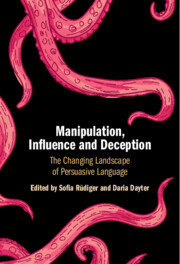Book contents
- Manipulation, Influence and Deception
- Manipulation, Influence and Deception
- Copyright page
- Contents
- Figures
- Tables
- Contributors
- I (Re)framing Persuasion
- II Persuasion and (New) Contexts of Use
- III The Dark Side of Persuasion
- IV Persuasion and Algorithms
- 11 Disinformation and Algorithms
- 12 Charismatic Speech Breathing
- 13 Appeals to Expertise Make Robots Persuasive in Human-Robot Healthcare Interaction
- V Discussion
- Index
- References
11 - Disinformation and Algorithms
Amplification, Reception and Correction
from IV - Persuasion and Algorithms
Published online by Cambridge University Press: 10 June 2025
- Manipulation, Influence and Deception
- Manipulation, Influence and Deception
- Copyright page
- Contents
- Figures
- Tables
- Contributors
- I (Re)framing Persuasion
- II Persuasion and (New) Contexts of Use
- III The Dark Side of Persuasion
- IV Persuasion and Algorithms
- 11 Disinformation and Algorithms
- 12 Charismatic Speech Breathing
- 13 Appeals to Expertise Make Robots Persuasive in Human-Robot Healthcare Interaction
- V Discussion
- Index
- References
Summary
Disinformation and the spread of false information online have become a defining feature of social media use. While this content can spread in many ways, recently there has been an increased focus on one aspect in particular: social media algorithms. These content recommender systems provide users with content deemed ‘relevant’ to them but can be manipulated to spread false and harmful content. This chapter explores three core components of algorithmic disinformation online: amplification, reception and correction. These elements contain both unique and overlapping issues and in examining them individually, we can gain a better understanding of how disinformation spreads and the potential interventions required to mitigate its effects. Given the real-world harms that disinformation can cause, it is equally important to ground our understanding in real-world discussions of the topic. In an analysis of Twitter discussions of the term ‘disinformation’ and associated concepts, results show that while disinformation is treated as a serious issue that needs to be stopped, discussions of algorithms are underrepresented. These findings have implications for how we respond to security threats such as a disinformation and highlight the importance of aligning policy and interventions with the public’s understanding of disinformation.
Keywords
Information
- Type
- Chapter
- Information
- Manipulation, Influence and DeceptionThe Changing Landscape of Persuasive Language, pp. 223 - 249Publisher: Cambridge University PressPrint publication year: 2025
References
Accessibility standard: Inaccessible, or known limited accessibility
Why this information is here
This section outlines the accessibility features of this content - including support for screen readers, full keyboard navigation and high-contrast display options. This may not be relevant for you.Accessibility Information
Content Navigation
Allows you to navigate directly to chapters, sections, or non‐text items through a linked table of contents, reducing the need for extensive scrolling.
Provides an interactive index, letting you go straight to where a term or subject appears in the text without manual searching.
Reading Order & Textual Equivalents
You will encounter all content (including footnotes, captions, etc.) in a clear, sequential flow, making it easier to follow with assistive tools like screen readers.
Visual Accessibility
You will still understand key ideas or prompts without relying solely on colour, which is especially helpful if you have colour vision deficiencies.
You benefit from high‐contrast text, which improves legibility if you have low vision or if you are reading in less‐than‐ideal lighting conditions.
